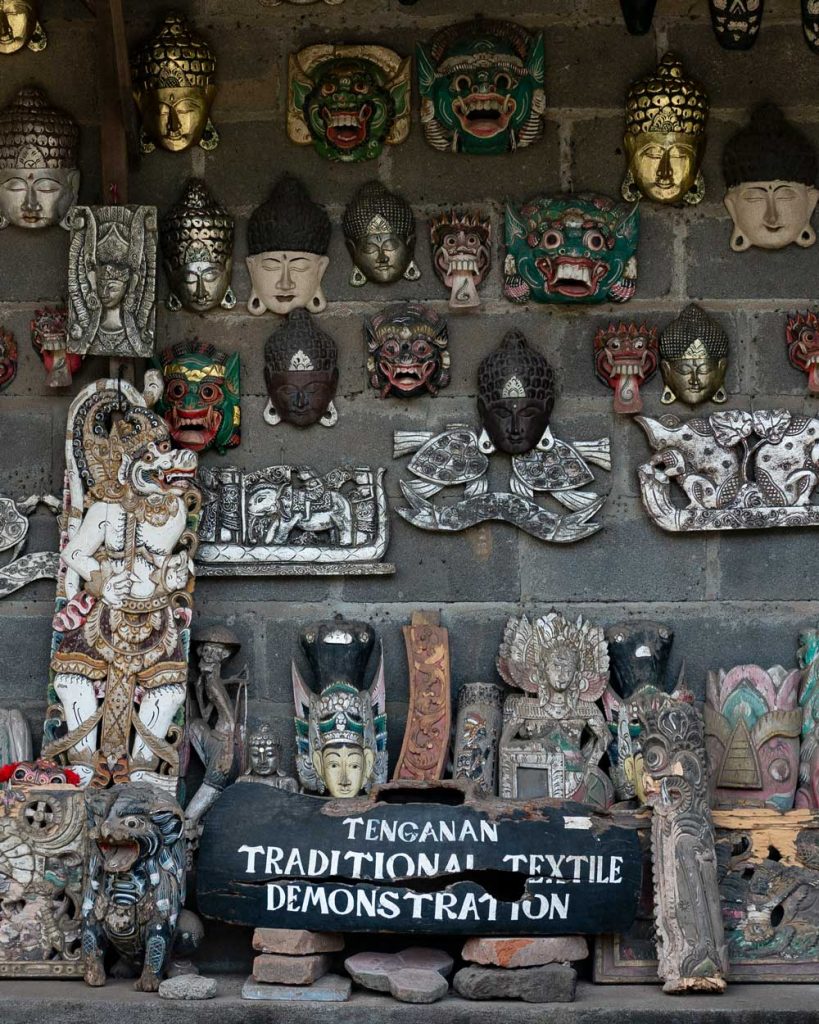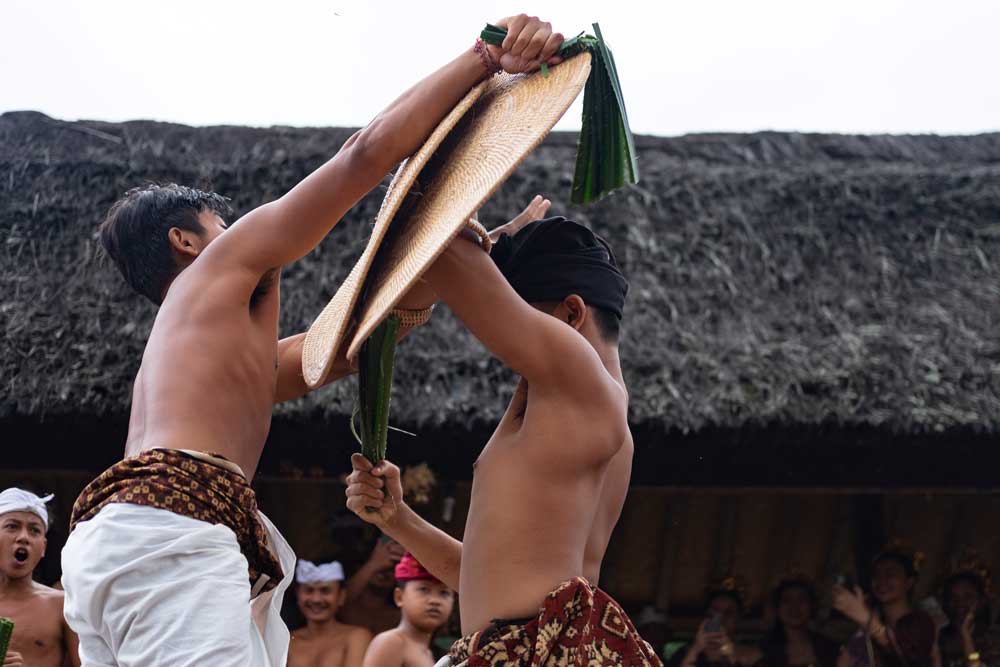
Found 3km north from the popular coastal town of Candidasa, Desa Adat Tenganan Pegringsingan (Traditional Village of Tenganan Pegringsingan) is the cultural and administrative centre of the Tenganan area. This land, from the floodplains to the dramatic rolling hills of Karangasem, was said to be bestowed upon its residents by Indra, the God of War himself.
Referred to as Bali Aga, or indigenous Balinese, the people of Tenganan Pegringsingan are a window into the ways and customs of an ancient Bali. The community here has a distinct culture from the majority of Bali; protected within their ‘god-given’ land, their unique laws and customs have helped to retain the traditional village structure and its way of life to this day.
Pandan Wars and the double-ikat cloth are what Desa Tenganan (Tenganan Village) are most known for, but this Bali Aga community is so much more than what it shows in blood and cloth.
Pride Over Prejudice

The term aga is an ancient Javanese word for mountain, and so Bali Aga is more precisely translated as ‘mountain people of Bali’. It is used as a word to describe Bali’s indigenous population.
The story goes that between the 8th and 14th centuries, Bali was ruled under two dynasties (Warmadewa and Jaya) of the Bedahulu Kingdom. This was centred in Pejeng, Gianyar, tied to many of the archaeological sites near there including Goa Gajah, Yeh Pulu and Gunung Kawi. This was Bali’s ‘ancient period’, which ended when the Hindu-Javanese Majapahit Empire thundered into Bali in 1343, successfully invading the island and beginning their long, defining reign. The influence of this empire has been the source of much of the Balinese culture we see today: the rituals, temples, palaces and arts.
The Bali Aga communities — better terms are Bali mula (original Balinese) or Bali kuno (ancient Balinese) — were often situated in distant or hard to reach areas, reducing their engagement with and therefore influence of the Majapahit culture. As a result, certain villages will have their own customs that do not conform to the established Balinese Hinduism of today.
For the villagers of Tenganan Pegringsingan however, non-acculturation to the Majapahit was very much a deliberate choice, one stemming from the pride of their ancestry and the legend of their founding.
The Chosen People of Dewa Indra

The origin story of the village helps to explain why the Tengananese are so proud of their heritage.
After the bloody war between Dewa Indra, God of War, and the malevolent King Mayadenawa who ruled over Bedahulu (the origin story of Galungan), the world was considered dirtied and a sacrifice was needed for purification. Indra offered his own holy horse, Oncesrawa, to be sacrificed. The horse, hearing of its impending death, ran to the hills. Indra asked the wong peneges, warriorsof the Bedahulu Kingdom, to search for Oncesrawa. Upon finding the horse, though already dead, Dewa Indra rewarded their efforts and said they could have the lands for as far as the stench of the horse’s carcass could be smelled. Craftily, the peneges troop cut up the horse’s body and spread it to the corners of the valley, with its right legs brought to Bukit Kangin (east ridge) and left legs brought to Bukit Kauh (west ridge). Indra noticed their gall and ingenuity, he exclaimed that they were allowed to lay claim to this land — and from there and then on, they would worship him.
So, in this guarded valley pocket beneath the mountains, Tenganan was claimed by these warriors of Bedahulu, its name derived from being the ‘centre point’ (tengah meaning centre) between the east and west ridge. Also identified by their unique craft, the double-ikat gringsing cloth, the central village and its community came to be known as Tenganan Pegringsingan.
Inside Desa Tenganan

The Tenganan area is 917 hectares of prosperous forest and farmland, managed by the main village (Desa Adat Tenganan Pegringsingan) and its community of around 760 people. Visitors are welcome to explore the surroundings and witness the everyday life of residents.
If coming from the coast, from Candi Dasa, the main entrance of the village is found in the south, where visitors are asked to register and make a donation before entering. The majority of the main village is found along one long corridor, stretching south to north, terracing up towards the foothills. Left and right, the family compounds are found behind stone walls, and in between this central strip are the communal buildings, the bale petemuan, where different groups will gather, ceremonies are held, and ritual tools and accessories are stored.
On normal days, the residents will set up tables of their arts and crafts for visitors to see and buy — palm-leaf manuscripts and drawings, paintings, carvings and cloths. Of course, the namesake cloth from Tenganan Pegringsingan is the village’s original and most famous craft.



Gringsing, takes its name from two words: gring and sing, meaning sickness/disease and no/reject respectively, or ‘no sickness’. Considered sacred, legend claims its ability to ward off sickness, and to grant its wearer prosperity. They are worn by the Tengananese during important rituals and ceremonies, becoming an iconic visual during auspicious days. Sanctity aside, the handmade textile is highly coveted because of its impressive craftsmanship; its creation is a time- and labour-intensive, using a ‘double-ikat’ process only found in three other places in the world.
Visitors can see yarns being pulled and organised at house fronts, clumps of naturally-dyed yarn drying in the sun, or indeed enter one of the homes to see the weaving in process, the women working away on their traditional backstrap looms.
At the northern tip of Desa Tenganan, a gateway leads out into the hills, where an ancient temple courtyard, Pura Puseh Tenganan, is found, often the village’s sacred buffalos will be grazing here.
Theatre of the Universe
According to one of the trusted sources on Tenganan, Urs Ramseyer, who wrote the book ‘The Theatre of the Universe’, this village’s isolation comes from a deep mission. He explains Tenganan as being a settlement created by Indra, made as a ‘microcosm’ of the larger universe following his divine design. Lord Indra tasked the inhabitants to safeguard the purity and cleanliness of the land. “The concept of territorial, bodily and spiritual purity and integrity is of paramount importance to the culture of this village,” explains Ramseyer. This belief explains the insular nature of the village over the centuries, protecting themselves from external impurities. It also explains the infinite cycle of ritual and ceremonies done to ensure that ancestors, gods and demons are placated and the lands surrounding remain pure.


Thus, during the village’s big ceremonies is when visitors can see Tenganan in its full regalia when its philosophy is made visual, tangible.
The Tenganan calendar is similar to the Gregorian, made up of 12 months (known as sasih). Every month will have its important ceremonies, lasting one to three days, but the fifth month (sasih kelima) is the pinnacle of the ritual year. This is the month of Usaba Sambah, a month-long ceremony filled with prayers, sacred dances, sacrifices, ceremonial foods, ritual swings, gatherings… all ending in the ‘climax’ of mekare-kare, or ‘perang pandan’ i.e. the famed Pandan Wars.
The Pandan Wars, lasting for two days at the end of the fifth month, is therefore the best time to visit Tenganan Pegringsingan. Normally in the months of June or July, these two days are an ultra-condensed showcase of what Tenganan is all about and one can witness so much of the community’s uniqueness in a short time. Traditional dress, instruments, dance, food and ritual will all be on show.
The most visible rituals include: Manyunan, where all of the young daha (young women), dressed head-to-toe in their best gringsing cloth and other accoutrements, take their seats on age-old ritual swings, which are then turned by the teruna (young men). The swing is symbolic of the cyclical nature of life — these young Tengananese to keep the wheels turning another generation.
Then comes the Pandan Wars. Taking place in front of one of the bale petemuan pavilions, the stage is set for battle. The young teruna men take their turns to face an opponent with bunched, thorny pandan leaves in one hand and a rattan shield in the other.

Then, to the tune of the sacred selonding gamelan, the fights begin. Chaotic scenes as each warrior scrambles and wrestles in an effort to grate the skin of their opponent with the sharp thorns of the pandan. Tabuh Rah. Blood sacrifice. They honour Dewa Indra, God of War, with their bloody battle, their blood a gift to the earth. The atmosphere is electric and the surrounding crowds cheer and jeer in unison as each exciting but short-lived combat takes place.
Still, with every strike, with every thorn that shreds the skin, with every drop of blood that quenches the ground beneath their feet, there are smiles all around. After each round the beaming fighters embrace, their deed is done. There are no winners or losers here, only a commitment to the community. When enough has been spilt, the warriors take turns to dress each other’s wounds, then sit together in a shared meal known as megibung.
The Usaba Samba ritual is the denouement of this particular Bali Aga community, before the curtains close on this ‘theatre’ for another year.
A more detailed account of Desa Adat Tenganan Pegringsingan can be found in ‘TIMELESS Bali — Volume 2,’ a special annual publication by by NOW! Bali.







